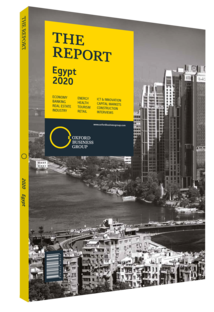How Egypt's banking policies are supporting private sector lending
Higher interest rates following the flotation of the Egyptian pound in 2016 made it costly for businesses and individuals to obtain funding from Egyptian banks. The depreciation of the currency also raised input costs for businesses and reduced their ability to expand operations, thereby reducing demand for funding to cover capital expenditure. Banks, meanwhile, found it easier to lend to the government in a high interest rate environment, further restricting private sector lending growth and solidifying a trend that has persisted in the domestic market. Indeed, banks held LE2.4trn ($147.9bn) in government debt in September 2018, while their aggregate lending to private sector stood at a comparatively modest LE804.8bn ($49.6bn).
Policy Changes
An evolving monetary environment offers some hope of a favourable change in lending patterns. An improving inflation scenario has meant that the Central Bank of Egypt (CBE) has been able to loosen its monetary policy since early 2018. An overnight deposit rate that stood at nearly 19% in January 2018 was reduced to below 17% at the start of 2019 and just over 12% by January 2020. However, some observers have pointed out that, despite the availability of cheaper lending, a significant expansion in credit growth is dependent on a second area of monetary policy. Increasing money supply is, in their view, a necessary stage in the process of stimulating lending through policy tools. The CBE increased the reserve requirement ratio (RRR) for banks to 14% in late 2017, during a period of high inflationary pressures. This reduced Egypt’s money supply by LE400bn ($24.7bn) and undermined the ability of banks to extend credit to customers, according to Cairo-headquartered investment bank Sigma Capital. With inflationary fears receding, the RRR is once more a viable tool at the CBE’s disposal. For advocates of monetary policy-driven lending, a combination of reducing policy rates and boosting money supply through an alteration of the RRR is the fastest route to loan growth over the short term.
Another way to free up capital for lending is to making it more expensive for banks to hold government securities. In November 2018 the Cabinet approved a proposed amendment to the tax code that requires banks to include Treasuries income as part of their taxable income. The effects of this change are expected to be seen in 2020 and will vary from bank to bank depending on their asset allocation, the cost of funding and the proportion of their interest income derived from their Treasuries departments. However, one likely consequence of the move is a greater desire on the part of banks to shift their income from government securities towards private sector lending.
Implications
Egypt’s banks succeeded in increasing their loan books even during the recent downward phase in the economic cycle. Moreover, their reliance on government securities for a considerable portion of their interest income is as much a result of low demand for business loans as a strategic decision on their part. Nevertheless, a shift in lending patterns is a desirable outcome for the industry and the wider economy.
Moving away from a focus on short-term lending for working capital purposes towards longer-term credit extension is expected to enable the banking sector to serve as a driver of private sector growth and thereby support economic development. As of June 2020 the monetary policy being pursued by the CBE appear to favour this outcome. In March 2020 the CBE reduced the overnight deposit rate by 300 basis points to 9.25% in a bid to support the economy during the uncertainty caused by the global Covid-19 pandemic.
Bringing the policy rate into single-digit territory was considered by many observers to be a prerequisite for the corporate sector to increase its capital spending and tap domestic banks to fund it. Over the short term the effects of the Covid-19 crisis are likely to suppress appetite for credit, but the fundamental conditions of a more productive aggregate balance sheet for the banking industry seem to be falling into place.
You have reached the limit of premium articles you can view for free.
Choose from the options below to purchase print or digital editions of our Reports. You can also purchase a website subscription giving you unlimited access to all of our Reports online for 12 months.
If you have already purchased this Report or have a website subscription, please login to continue.

